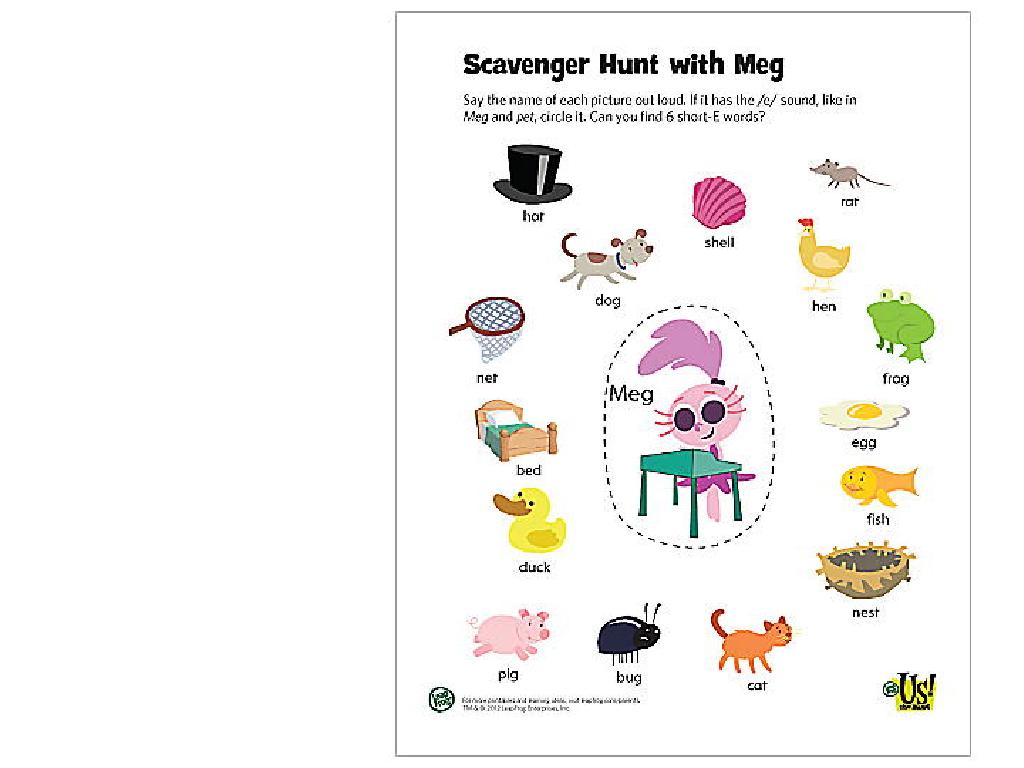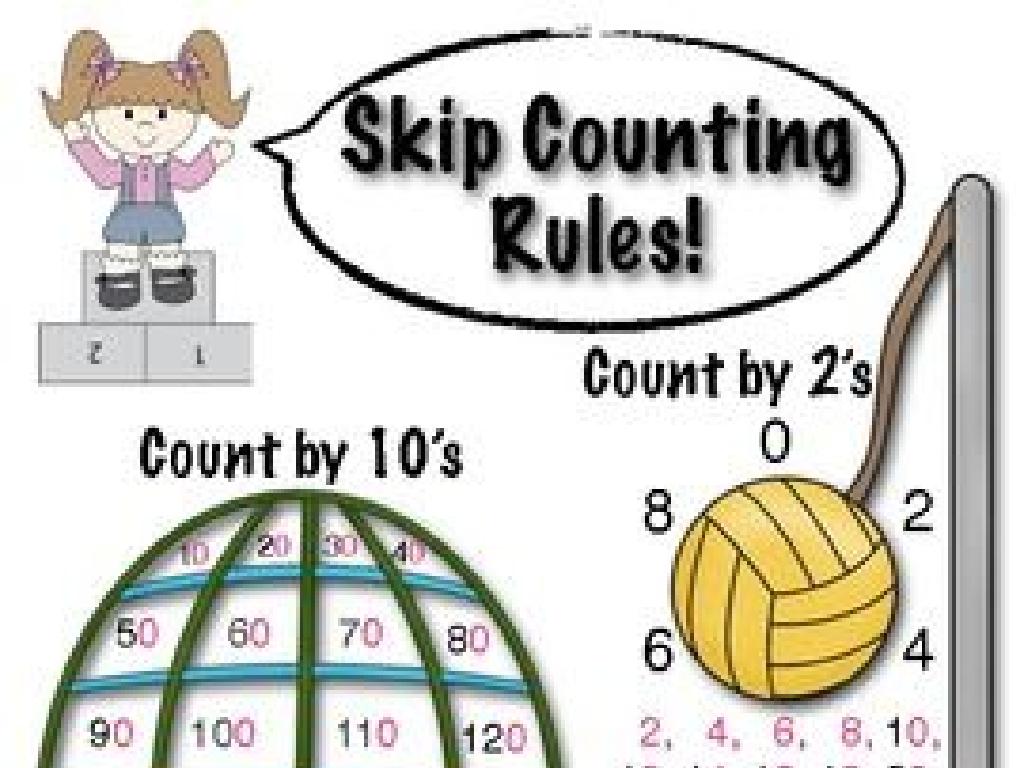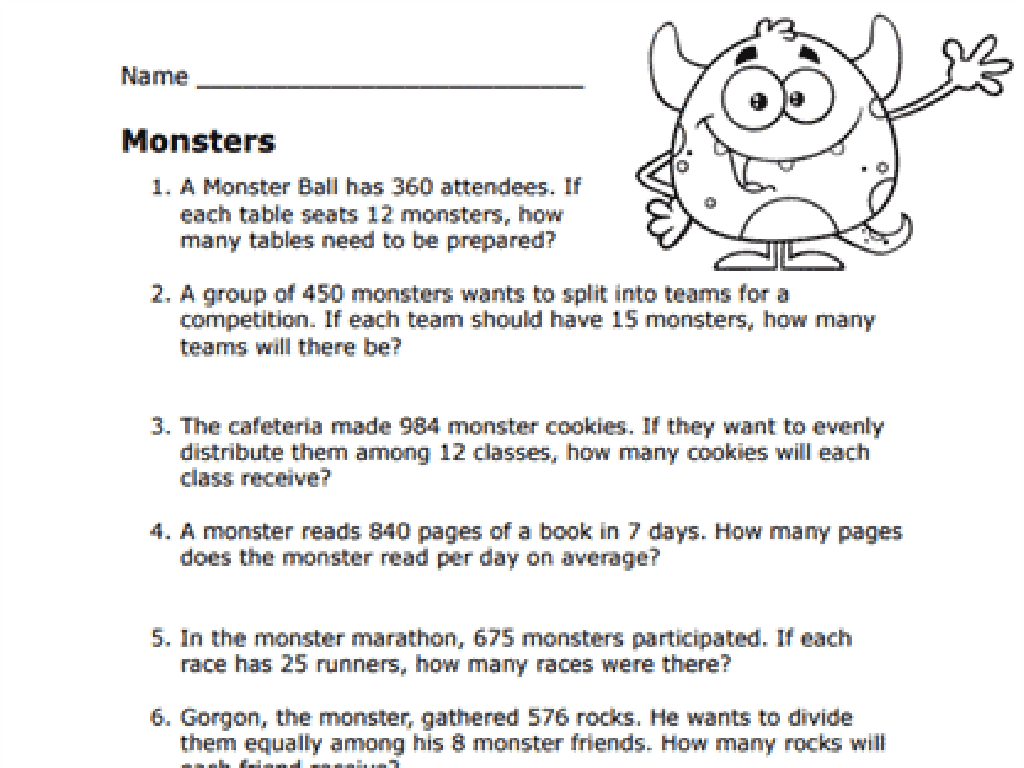Multiply By 5
Subject: Math
Grade: Third grade
Topic: Multiplication Skill Builders
Please LOG IN to download the presentation. Access is available to registered users only.
View More Content
Today’s Adventure: Multiplying by 5!
– Multiplication as fast addition
– Instead of adding 5 five times, we can multiply 5 x 5.
– Multiplying numbers by 5
– 5 times any number is like adding that number 5 times.
– Patterns in multiplying by 5
– Numbers ending in 0 or 5 when we multiply by 5.
– Why multiplication matters
– It helps us solve problems quickly and efficiently.
|
Begin the lesson by explaining multiplication as a method of repeated addition, which makes counting faster and easier. Show that multiplying by 5 is the same as adding a number five times. Highlight the pattern that results when we multiply numbers by 5, typically ending in 0 or 5, which makes it easier to remember. Emphasize the importance of multiplication as a fundamental skill in math that enables us to solve problems more efficiently. Use examples like 5 x 2 = 10 and 5 x 3 = 15 to illustrate these points. Encourage students to look for patterns and use them to check their work.
Understanding Multiplication: Multiply by 5
– Multiplication: fast track to addition
– Example: 5 times 2 equals 10
– Same as adding 5 twice: 5 + 5
– Multiplying by 5 is quick!
– Instead of adding 5 over and over, we can multiply to find the answer faster.
– Practice with different numbers
– Try 5 times 3, 5 times 4, and so on to see the pattern!
|
This slide introduces the concept of multiplication as a method for adding the same number quickly. Use the example of 5 times 2 to show that it’s the same as adding 5 twice, which equals 10. Emphasize that multiplication is a shortcut for addition when dealing with multiple groups of the same number. Encourage students to practice multiplying by 5 with different numbers to understand the pattern and gain fluency in this skill. Activities can include using objects to count in groups of 5, skip counting by 5s, and solving multiplication problems on a number line.
The Magic of Multiplying by 5
– Multiplying by 5 patterns
– Notice how 5, 10, 15, 20… all have a pattern?
– Products end with 0 or 5
– Like 5×2=10 and 5×3=15, see the pattern in the last digit?
– Skip count by 5 for answers
– Just like hopscotch, jump 5 steps to get the next number!
|
This slide introduces the concept of multiplication by 5, highlighting the patterns that emerge. Emphasize that when we multiply any number by 5, the result will always end in either 0 or 5. This is a key pattern that can help students check their work for accuracy. Encourage students to practice skip counting by 5 as a strategy to quickly find the answers to multiplication problems. For example, if they know 5×4 is 20, then 5×5 is just 5 more, which is 25. Use a number line in class to visually demonstrate skip counting by 5s. This will help solidify the concept and prepare them for more complex multiplication.
Let’s Practice Multiplying by 5!
– Solve: 5 x 3, 5 x 6, 5 x 9
– What do you get when you multiply 5 by 3, 6, and 9?
– Count by 5s: 5, 10, 15…
– Practice counting in 5s to help with multiplication
– Pair up for group activity
– Solve together: 5 x 4, 5 x 7
– Work with a friend to find the answers
|
This slide is designed to engage students in practicing multiplication by 5 through both individual and group activities. Start by having students solve the multiplication problems 5 x 3, 5 x 6, and 5 x 9 on their own to assess their understanding. Then, lead the class in counting by 5s to reinforce the concept of multiplication as repeated addition. For the group activity, have students pair up and work together to solve 5 x 4 and 5 x 7, encouraging collaboration and peer learning. As a teacher, circulate the room to provide assistance and ensure that each student is participating and grasping the concept. Prepare to offer hints or strategies as needed, such as using fingers to count by 5s or visualizing groups of 5 objects. The goal is to build confidence and fluency in multiplying by 5.
Multiplying by 5 with Real Objects
– Visualize multiplication with objects
– Use fingers for counting by fives
– Hold up 5 fingers, then another 5, and so on
– Group pencils in sets of 5
– Arrange pencils in groups to see the total count
– Count coins in multiples of 5
– Practice with nickels to understand the concept
|
This slide is aimed at helping third-grade students understand the concept of multiplication by using tangible objects they are familiar with. Start by explaining that multiplication is a way to add the same number several times. Show them how to use their fingers to count by fives, which is a practical and accessible method. Then, move on to grouping pencils in sets of five to visualize the multiplication process. Finally, use coins, such as nickels, to demonstrate how counting by fives can be applied to money. Encourage the students to touch and move the objects as they count, reinforcing the tactile learning experience. The class demonstration should be interactive, allowing students to participate and practice the grouping themselves.
Games with Multiplying by 5
– Play ‘High Five Multiplication’
– An interactive game to multiply numbers by 5
– Teamwork makes learning fun
– Practice multiplication with peers
– Work with friends to solve multiplication problems
– Enjoy and learn through play
– Games help reinforce math skills in an enjoyable way
|
The ‘High Five Multiplication’ game is designed to make learning multiplication by 5 engaging and interactive for third graders. By incorporating teamwork, students can help each other and practice together, enhancing their understanding of the concept. Encourage students to communicate and collaborate as they play. This activity not only reinforces their multiplication skills but also promotes a positive learning environment. As a teacher, observe the students’ interactions and provide guidance when necessary. Offer variations of the game to cater to different skill levels within the class. Possible activities include: a timed ‘High Five Relay’, group challenges, or ‘Multiplication Tag’ where correct answers allow students to ‘tag’ their peers.
Show What You Know: Multiplying by 5
– Complete the multiplication worksheet
– Solve problems involving multiplying by 5
– For example, 5 x 4 is the same as 5 + 5 + 5 + 5
– Think about different methods used
– Did you skip count or use repeated addition?
– Share your answers and methods in class
– Discuss with classmates to learn new strategies
|
This slide is designed to engage students in practicing their multiplication skills, specifically focusing on multiplying by 5. Provide individual worksheets with a variety of problems that require multiplying by 5. Encourage students to solve these problems using methods they are comfortable with, such as skip counting or repeated addition. After completing the worksheet, create a collaborative classroom environment where students can share their answers and the different methods they used to solve the problems. This will help them learn from each other and understand that there can be multiple ways to reach the same answer. As a teacher, facilitate the discussion and highlight the benefits of each method, ensuring that each student has the opportunity to share and listen.
Class Activity: Multiplication Relay
– Form teams for the relay
– Solve a ‘multiply by 5’ problem
– Example: 5 x 3 = ? Once solved, pass the baton.
– Pass the baton quickly
– Aim for correct answers to win!
– Check answers at the end of the relay.
|
This activity is designed to encourage teamwork and quick thinking while practicing multiplication by 5. Divide the class into small groups, and give each team a baton (this could be any object like a ruler or a pencil). Each team member must solve a different ‘multiply by 5’ problem before passing the baton to the next teammate. The first team to finish with all correct answers wins a small prize. Make sure to have a variety of problems ready for the students to solve. This will help students to reinforce their multiplication skills in a fun and competitive way. Possible variations of the activity could include a mix of easier and harder problems, using a timer to add pressure, or having students create their own ‘multiply by 5’ problems to challenge other teams.
Wrapping Up: Multiplying by 5
– Recap multiplying by 5
We learned that multiplying by 5 is like adding a number 5 times.
– Homework: Multiplication practice
Complete the practice sheet with problems on multiplying by 5.
– Keep practicing your skills
The more you practice, the better you’ll get at multiplication.
– Aim to be a multiplication master!
|
As we conclude today’s lesson on multiplying by 5, remind the students of the key points we’ve covered. Reinforce the concept that when we multiply a number by 5, it’s the same as adding that number together five times. Distribute the homework practice sheet, which includes a variety of problems to help them reinforce what they’ve learned. Encourage students to complete the sheet and remind them that practice is essential in mastering multiplication. Praise their efforts and progress, and motivate them to keep practicing to become confident in their multiplication skills.






